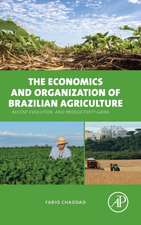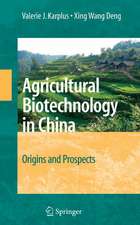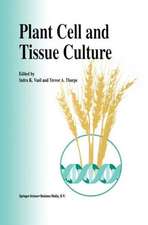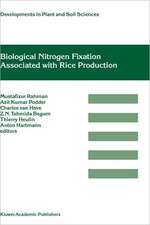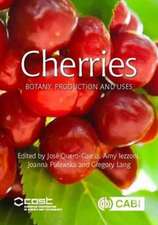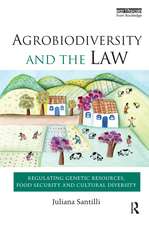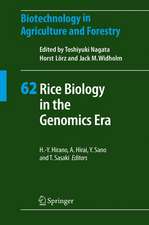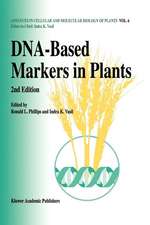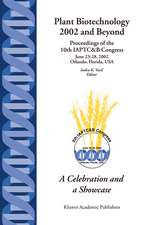Molecular improvement of cereal crops: Advances in Cellular and Molecular Biology of Plants, cartea 5
Editat de Indra K. Vasilen Limba Engleză Paperback – 22 noi 2012
Complementing and supplementing the breeding of major food crops, such as the cereals, which together account for 66% of the world food supply, with molecular breeding and genetic manipulation may well provide a grace period of about 50 years in which to control population growth and achieve sustainable development. In this volume, leading world experts on cereal biotechnology describe the production and commercialization of the first generation of transgenic cereals designed to substantially reduce or prevent the enormous losses to cereal productivity caused by competition with weeds, and by various pests and pathogens, which is an important first step in that direction.
| Toate formatele și edițiile | Preț | Express |
|---|---|---|
| Paperback (1) | 1222.49 lei 6-8 săpt. | |
| SPRINGER NETHERLANDS – 22 noi 2012 | 1222.49 lei 6-8 săpt. | |
| Hardback (1) | 1228.62 lei 6-8 săpt. | |
| SPRINGER NETHERLANDS – 31 mar 1999 | 1228.62 lei 6-8 săpt. |
Preț: 1222.49 lei
Preț vechi: 1490.84 lei
-18% Nou
Puncte Express: 1834
Preț estimativ în valută:
233.98€ • 241.13$ • 197.54£
233.98€ • 241.13$ • 197.54£
Carte tipărită la comandă
Livrare economică 01-15 martie
Preluare comenzi: 021 569.72.76
Specificații
ISBN-13: 9789401060165
ISBN-10: 9401060169
Pagini: 416
Ilustrații: VIII, 402 p.
Dimensiuni: 160 x 240 x 22 mm
Greutate: 0.58 kg
Ediția:Softcover reprint of the original 1st ed. 1999
Editura: SPRINGER NETHERLANDS
Colecția Springer
Seria Advances in Cellular and Molecular Biology of Plants
Locul publicării:Dordrecht, Netherlands
ISBN-10: 9401060169
Pagini: 416
Ilustrații: VIII, 402 p.
Dimensiuni: 160 x 240 x 22 mm
Greutate: 0.58 kg
Ediția:Softcover reprint of the original 1st ed. 1999
Editura: SPRINGER NETHERLANDS
Colecția Springer
Seria Advances in Cellular and Molecular Biology of Plants
Locul publicării:Dordrecht, Netherlands
Public țintă
ResearchCuprins
1. Molecular Improvement of Cereal Crops — An Introduction.- 2. Methods of Genetic Transformation: Electroporation and Polyethylene Glycol Treatment.- 3. Methods of Genetic Transformation: The Gene Gun.- 4. Methods of Genetic Transformation: Agrobacterium tumefaciens.- 5. Expression and Regulation of Transgenes for Selection of Transformants and Modification of Traits in Cereals.- 6. Transgenic Cereals: Triticum aestivum (wheat).- 7. Transgenic Cereals: Oryza sativa (rice).- 8. Transgenic Cereals — Zea mays (maize).- 9. Transgenic Cereals — Hordeum vulgare (barley).- 10. Transgenic Cereals — Avena sativa (oat).- 11. Transgenic Cereals: Secale cereale and Sorghum bicolor (rye and sorghum).- 12. Transgenic Cereals: Triticale and Tritordeum.- 13. The Grasses as a Single Genetic System.
Recenzii
`This is the most comprehensive text currently available on cereal tarnsformation and appears at an opportune time when transformation systems are established for all the major cereals, although these are far from routine. It will undoubtedly become an important source for research scientists who are working on aspects of cereal transformation. It will also be of wider interest to those working on cereal production and utilization and indeed to anyone who wishes to find out why there is currently so much excitement about the genetic engineering of cereals.'
Plant Growth Regulation, 30 (2000)
`The book will certainly be useful to plant scientists, breeders, biotechnologists, and agronomists interested in the improvement of cereals. It provides a wonderful up-to-date comprehensive overview of the field, with contributions of value to the specialist and also suitable to a broader readership.'
Plant Science, 158 (2000)
Plant Growth Regulation, 30 (2000)
`The book will certainly be useful to plant scientists, breeders, biotechnologists, and agronomists interested in the improvement of cereals. It provides a wonderful up-to-date comprehensive overview of the field, with contributions of value to the specialist and also suitable to a broader readership.'
Plant Science, 158 (2000)







